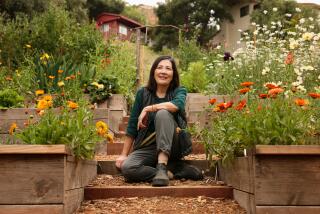Roselle: Plant now for hibiscus tea flowers later
If all goes well, Alicia Bacon’s plot at the Ocean View Farms community garden in Mar Vista will be a garden of scents this summer, an olfactory orchestra of plumeria, the flowering vine known as Exotic Love, flowering ginger and -- last but not least -- roselle, (Hibiscus sabdariffa) also known as rosa de jamaica.
Roselle isn’t an easy plant to grow. Bacon tries it every year, and last summer she had a better crop than usual. “I think it loved all the heat,” she said at the time.
It may be barely spring, but now is the time to be thinking of July sun and roselle seeds. The plant can be started from cuttings, but seeds are easily available online.
Before you sow, a little lesson in flower physiology: Summer is when the roselle starts to bloom, sending out creamy yellow blooms surrounded by the calyx, a protective row of fleshy, vermillion-colored leaves called sepals. A secondary row, the epicalyx, grows outside. After the flower petals fall off, the calyx remains, covering a green seed-filled ovary. Wait a few weeks, and the calyx can be harvested.
When dried, these calyx (inaccurately called “hibiscus flowers”) become the basis for agua de flor de jamaica, hibiscus tea, a standard in Mexican restaurants. In the Caribbean, where the drink is called red sorrel, it’s sometimes combined with rum. The taste is more sour than sweet, similar to cranberry juice.
The calyx (and ovary) also may be cut up fresh for salads or used for syrups, sauces, jams, chutneys, martinis. The leaves are edible, tasting a bit like spinach. In the southeast Indian state of Andhra Pradesh, they are a primary ingredient for the local cuisine. The leaves also are used topically, heated and applied to cracked heels and sore feet.
The plant is native to Africa -- Angola, most likely -- but has spread globally in the tropics. It was carried by Dutch colonizers to Asia and grown for the stalk’s fibre, which was used for making sacks.
As Bacon noted, roselle likes it hot -- at least 12 hours of sun daily. Start the seeds in a large pot because the plant doesn’t like to be transplanted from pot to pot. Once established in the ground, water sparingly.
The Global Garden, our look at multicultural Los Angeles through the lens of its landscapes, appears here on Tuesdays. For easy way to follow the L.A. scene, bookmark L.A. at Home and join us on Facebook, Twitter and Pinterest.






